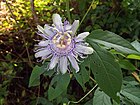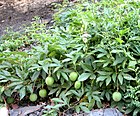Note: This is a project under development. The articles on this wiki are just being initiated and broadly incomplete. You can Help creating new pages.
Passiflora incarnata
Passiflora incarnata, commonly known as maypop, purple passionflower, true passionflower, wild apricot, and wild passion vine, is a fast-growing perennial vine with climbing or trailing stems. A member of the passionflower genus Passiflora, the maypop has large, intricate flowers with prominent styles and stamens. One of the hardiest species of passionflower, it is both found as a wildflower in the southern United States and in cultivation for its fruit and striking bluish purple blooms.
Uses
Parts Used
Chemical Composition
incarnata contains simple indole alkaloids based on β- carboline ring system namely harman, harmol, harmine, harmalol and harmaline (21). Content of harman and harmine, determined by direct spectrofluorimetric methods on TLC plates, and has been reported to be 10–20 g/100 ml in the medicinal fluid extract of P. [1]
Common names
| Language | Common name |
|---|---|
| Kannada | |
| Hindi | |
| Malayalam | |
| Tamil | |
| Telugu | |
| Marathi | NA |
| Gujarathi | NA |
| Punjabi | NA |
| Kashmiri | NA |
| Sanskrit | |
| English | maypop, purple passionflower, true passionflower, wild apricot |
Properties
Reference: Dravya - Substance, Rasa - Taste, Guna - Qualities, Veerya - Potency, Vipaka - Post-digesion effect, Karma - Pharmacological activity, Prabhava - Therepeutics.
Dravya
Rasa
Guna
Veerya
Vipaka
Karma
Prabhava
Habit
Identification
Leaf
| Kind | Shape | Feature |
|---|---|---|
| Simple | Leaves are alternate and palmately 3-lobed and occasionally 5-lobed | Measuring 6–15 centimetres (2.4–5.9 in). They have two characteristic glands at the base of the blade on the petiole. |
Flower
| Type | Size | Color and composition | Stamen | More information |
|---|---|---|---|---|
| Bisexual | Broadly ovate | Cream white | Flowers have five bluish-white petals. They exhibit a white and purple corona, a structure of fine appendages between the petals and stamens. The large flower is typically arranged in a ring above the petals and sepals |
Fruit
| Type | Size | Mass | Appearance | Seeds | More information |
|---|---|---|---|---|---|
| Simple Fruit | Ovoid | 2-7 cm long, 1-2.5 cm broad | Yellowish berry | {{{6}}} |
Other features
List of Ayurvedic medicine in which the herb is used
Where to get the saplings
Mode of Propagation
How to plant/cultivate
Commonly seen growing in areas
Photo Gallery
References
External Links
- Ayurvedic Herbs known to be helpful to treat Boils
- Ayurvedic Herbs known to be helpful to treat Wounds
- Ayurvedic Herbs known to be helpful to treat Earaches
- Ayurvedic Herbs known to be helpful to treat Liver problems
- Herbs with Fruits used in medicine
- Herbs with Leaves used in medicine
- Herbs with common name in English
- Habit - Herbs
- Index of Plants which can be propagated by Seeds
- Herbs that are commonly seen in the region of Tropical area
- Herbs
- Passifloraceae




